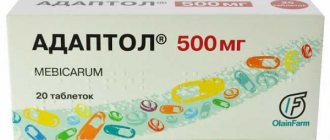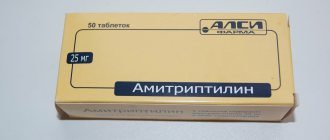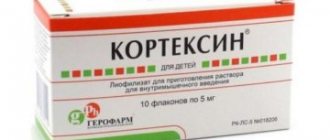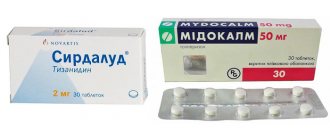Increases blood supply to areas subject to ischemia, relaxes the smooth tissue of brain vessels. Affects metabolism. Slows down the processes of phosphodiesterase and adenylate cyclase, increasing the levels of cyclicity of adenosine monophosphate and ATP (adenosine triphosphate). As a result, the blood vessels of the brain dilate, oxygen transportation improves, and the body’s resistance to hypoxia increases; the process of glucose absorption is activated, the process of metabolism and seratonin in the brain increases. Platelet dismerism decreases.
Pharmacokinetics
When taken orally, it is rapidly absorbed. Has a bioavailability of 60-70% . Maximum fills the blood plasma approximately an hour after use. The elimination period is 5 hours. Kaviton is excreted in the urine in the form of metabolic products. Saturation in plasma is about 15-20 ng/ml. Has the property of passing through the placenta. Biotransforms in the liver to the state of hydroxyapovinamic acid.
Mechanism of action:
- Selectively improves the blood supply to the brain.
- Improves microcirculation and hemorheological norms.
- Enhances the processing of glucose by brain tissue and supplies it with oxygen.
Side effects:
- Lowers blood pressure.
- Sometimes - extrasystole, increased heart rate.
Interaction with other drugs - while using heparin, the possible risk of bleeding increases.
Directions for use and dosage:
- Solution for injection - intravenously.
- Tablets - orally after meals.
The duration of treatment and dissolution is strictly as prescribed by the attending physician.
What is the difference between the drug Cavinton Comfort and Cavinton: analogues, difference, instructions for use
Cavinton and Cavinton Comforte are medications containing vinpocetine as an active ingredient. This component, acting on the tone of the walls of blood vessels, has a vasodilating effect, acting primarily selectively on ischemic areas of brain tissue.
Under the influence of vinpocetine, the rheological properties of blood and the deformability of red blood cells improve, which contributes to a better supply of oxygen to tissues fed by small capillaries. The tolerance of oxygen starvation by nerve cells under the influence of vinpocetine increases significantly.
Cavinton and its analogues
Analogues of the drug with the same active substance are described in the table:
| A drug | Dosage forms | Concentration of active substance, mg |
| Cavinton | Tablets for oral administration | 5 |
| Solution for intravenous infusion | 5 mg/ml | |
| Cavinton Comfort | Dispersible tablets | 10 |
| Cavinton Forte | Tablets for oral administration | 10 |
| Vinpocetine | 5 | |
| Telektol | 5, 10 |
Characteristics of the active substance
The effect of the active substance – vinpocetine – is aimed at improving cerebral circulation.
Pharmacodynamics
The effectiveness of the component is due to its ability to inhibit the enzyme phosphodiesterase, which subsequently leads to relaxation of myofibrils in the vascular wall by reducing the calcium concentration in the cytoplasm of smooth muscle fibers. The result of the effect of vinpocetine is the dilation of cerebral vessels, in which the substance has a special tropism.
Under the influence of vinpocetine, blood flow primarily increases in ischemic areas of the brain. As a result, oxygen saturation of the nervous tissue improves. The drug stimulates the utilization of glucose and increases the concentration of serotonin and dopamine in nerve cells. The ability of platelets to aggregate decreases, and the rheological properties of blood improve.
The effect of taking vinpocetine on systemic blood pressure is insignificant.
In the acute period of ischemic brain damage, the effect of vinpocetine on nervous tissue accelerates the extinction of general cerebral and focal neurological symptoms, improves memory and the ability to concentrate, as a result of which intellectual activity is activated.
Pharmacokinetics
Absorption of vinpocetine when taken orally occurs quickly. To achieve maximum concentration in blood plasma, 1 hour is enough. The substance is absorbed in the proximal intestine without being metabolized when passing through the intestinal wall.
Due to the peculiarities of the metabolism of the substance, patients with impaired liver and kidney function do not require dose adjustment. This property of the drug is due to its lack of ability to accumulate in the body.
Indications
The use of medications based on vinpocetine (Cavinton, Cavinton forte, Cavinton Comforte) is indicated in the following cases:
- cerebrovascular insufficiency,
- retinopathy,
- hearing disorders,
- vegetative disorders.
Cerebral blood flow disorders and neurological pathology
Vinpocetine preparations are effective for the following conditions:
- cerebral circulatory failure in acute or chronic form, including the acute stage of stroke and the residual period of acute cerebrovascular accident,
- transient ischemic attacks,
- encephalopathies of varying severity, having a discirculatory origin.
The remedy is also effective in the complex treatment of disorders of the autonomic nervous system during menopausal syndrome.
Cavinton in ophthalmological practice
In the field of ophthalmology, Cavinton in various forms finds its use in vascular diseases of the retina and choroid of the organ of vision. Preparations based on vinpocetine are effective for pathological conditions of various natures that arise against the background of:
- vascular atherosclerosis,
- vascular spasm,
- thrombosis and thromboembolism.
Vinpocetine preparations and otorhinolaryngology
Cavinton is used in the complex treatment of age-related, vascular, toxic and drug-induced hearing impairment, Meniere's disease, as well as dizziness of labyrinthine origin.
Adverse reactions
When using drugs containing vinpocetine, there is a possibility of the following adverse reactions:
| Organ system | Side effects |
| Hematopoiesis and the lymphatic system | Decrease in the content of formed elements in the blood and agglutination of red blood cells |
| Immunity | Hypersensitivity reactions |
| Trophism and metabolism |
|
| Nervous system, including the central nervous system |
|
| Organ of vision |
|
| Organs of hearing and balance |
|
| The cardiovascular system |
|
| Digestive tract |
|
| Skin and subcutaneous tissues | Hyperhidrosis |
| General reactions | Allergic reactions in the form of skin hyperemia, rashes and itching |
Contraindications
Contraindications for use are:
- acute period of hemorrhagic stroke,
- coronary heart disease, occurring in severe form,
- severe forms of heart rhythm disturbances,
- periods of pregnancy and breastfeeding,
- hypersensitivity to any of the ingredients.
Products containing vinpocetine are also not used in patients under the age group of 18 years, due to insufficient reliable data on the effectiveness and safety of the drug in this age category.
Cavinton Comfort - what is the difference?
The difference between Cavinton Comforte and its analogues lies in the dispersible structure of the tablet. This dosage form will be convenient for patients who have difficulty swallowing pills due to disorders of various origins, such as:
- dysphagia as a result of organic damage to the central nervous system (after severe cerebral strokes or traumatic brain injuries),
- individual characteristics,
- neurological diseases characterized by swallowing disorders (myasthenia gravis, myasthenic syndromes, etc.).
Cavinton Comforte dispersible tablet can be swallowed whole with plenty of water, or dissolved in the mouth until completely dissolved. The tablets have a pleasant orange flavor, which makes taking the medicine even more comfortable.
Instructions for use
The methods of using various drugs containing vinpocetine are similar. The difference between drugs lies in the dose of the active substance.
Cavinton Comfort
The drug is intended for oral use after meals. The daily dose for an adult patient is 30 mg, divided into three doses (one tablet three times a day). However, if necessary, the attending physician may individually prescribe a different regimen for taking the drug.
For patients with impaired renal and (or) liver function, no dose adjustment is required. A noticeable therapeutic effect should be expected a week after the start of treatment.
The Cavinton Comfort tablet can be dissolved in the mouth without swallowing until completely dissolved. This is how this drug differs from other tablets based on vinpocetine.
Solution for infusion Cavinton
The product is intended for intravenous administration using slow drip infusions no faster than 80 drops per minute. The medicine cannot be used for intramuscular and intravenous injections without dilution.
Before infusion, the concentrate should be diluted in physiological sodium chloride solution or any of the dextrose solutions:
The prepared infusion composition with vinpocetine should be used no later than 3 hours after preparation. The initial dose in a course of intravenous infusion is 20 mg in 500 ml of saline.
Having ensured that treatment is well tolerated, the daily dose is increased over two to three days, but not more than 1 mg per kilogram per day.
Thus, for a patient weighing 70 kg, on average, the optimal dose is 50 mg in 500 ml of saline infusion solution.
The average duration of the course of infusions ranges from 10 days to 2 weeks.
For patients with hepatic and (or) renal dysfunction, no dose adjustment is required.
The instructions for use indicate that after completing the course of intravenous infusions, treatment should not be interrupted - it should be continued in the form of taking one of the vinpocetine preparations in tablet form:
- Cavinton.
- Cavinton forte.
- Vinpocetine.
- Telektol.
- Cavinton Comfort.
The dosage is usually from 5 to 10 mg per dose with a frequency of two to three times a day. The course of taking tablets is long - from 1 to 2 months. On the recommendation of the attending physician, a second course of therapy can be carried out after 4-6 months.
Source: https://fr-dc.ru/oftalmolog/kavinton-komforte-instrukcziya-po-primeneniyu-i-otlichiya-ot-analogov
Cavinton forte
Cavinton Forte is a vinpocetine drug intended to improve cerebral blood flow and metabolic activity in brain tissue. Available in tablet form. Unlike Cavinton, it has additional components: lactose monohydrate, magnesium sterate, corn starch, colloidal silicon dioxides.
Pharmacology and pharmacokinetics of the drug:
Increases the brain's resistance to oxygen starvation and enhances the movement of glucose. Cavinton Forte concentrates ATP, stimulates metabolic processes in neurotransmitter systems. Improves the passage of red blood cells in blood vessels, enhances the effect of adenosine. It has a vasodilatory effect on blood vessels, reducing their resistance.
Easily penetrates through histohematic transitions, including the placenta, and is absorbed into breast milk.
Indications for use:
- Dizziness.
- Meniere's syndrome.
- Ischemic attacks.
- Traumatic brain injuries.
- Vascular dementia.
Contraindications:
- Extreme forms of IHD.
- Arrhythmia.
- Hemorrhagic strokes.
- Poor lactose tolerance.
- Allergic reactions to vinpocetine, periwinkle products.
- Pregnancy.
Directions for use: after meals. 1 tablet 3 times a day (no more than 30 mg.). The course of treatment is from 1 to 3 months (no more than 90 days). Prescribed by a doctor.
Domestic substitutes in ampoules
Preparations in the form of ampoules are not so popular. Most often, analogues that are cheaper than Cavinton are used. The most commonly prescribed is Vinpocetine, the cost of which in this form is four times lower.
Vinpocetine ampoules
The drug has a composition similar to Cavinton. The number of side effects is lower than when using tablets. Of particular importance in the instructions for use is the impossibility of taking it during hemorrhagic complications, that is, in conditions where the integrity of the blood vessels is compromised.
Finding an analogue of the drug Cavinton in any pharmacy is not difficult, and many of them are safer and more economical.








